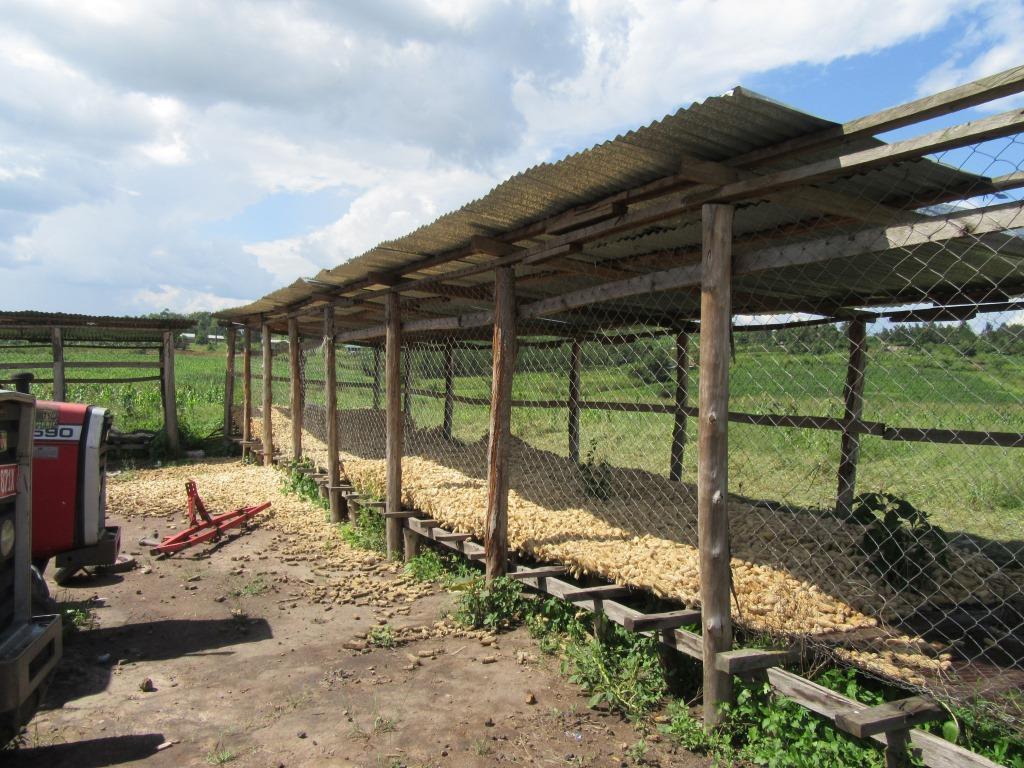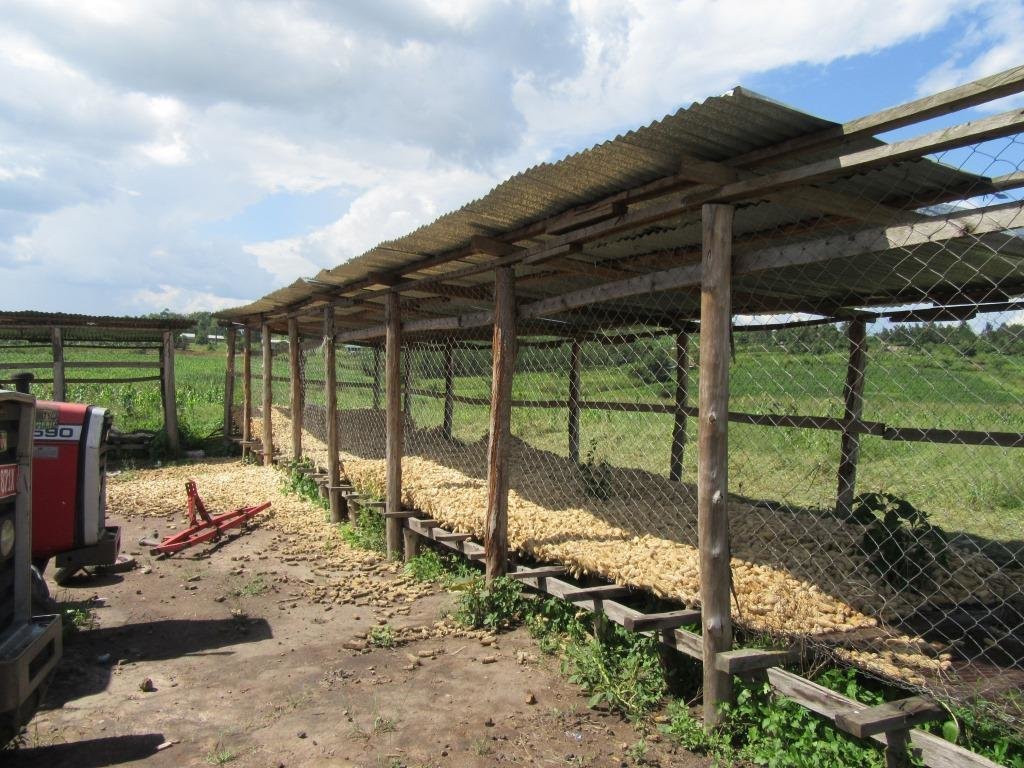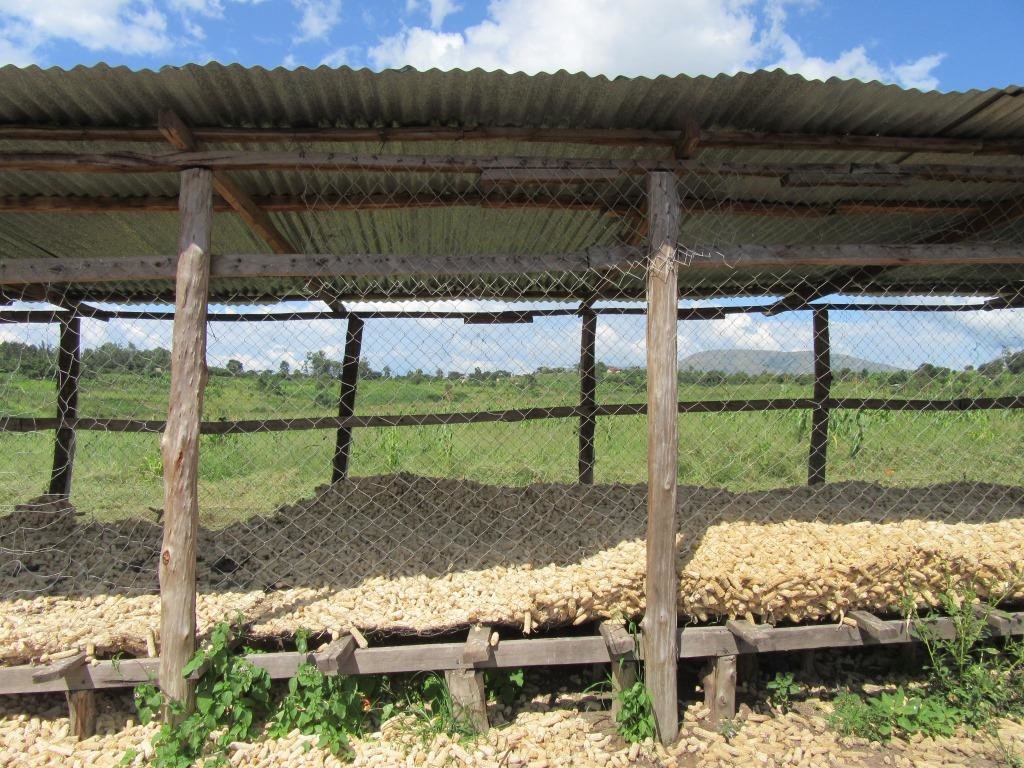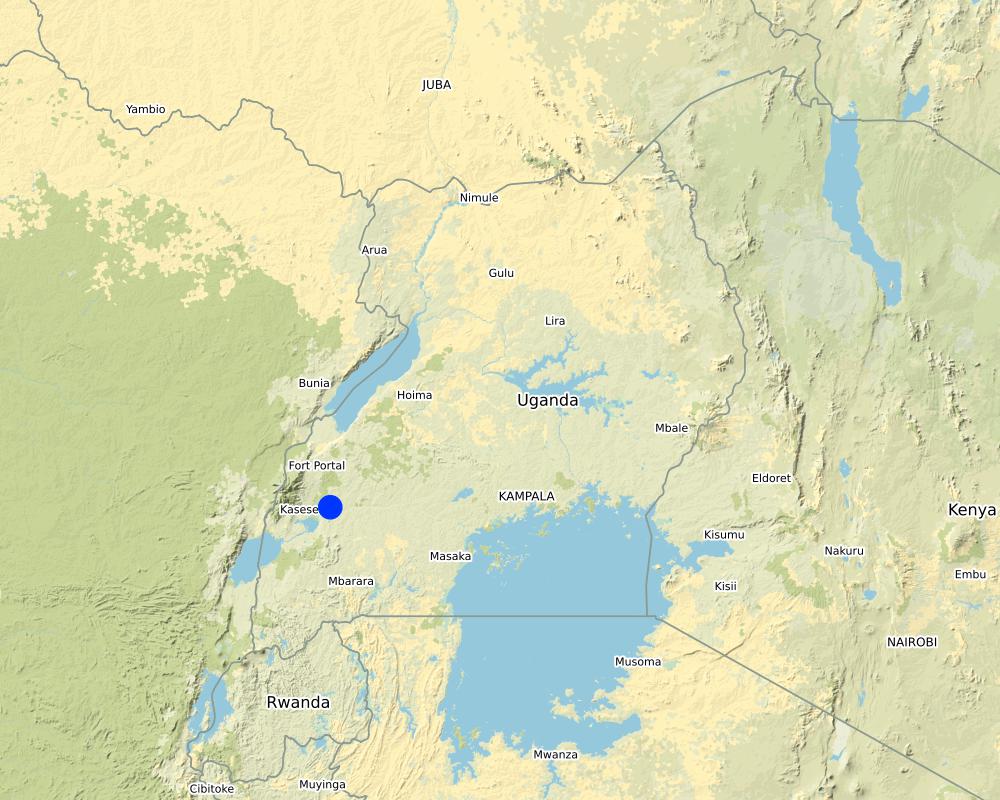Wire Mesh Maize Storage Crib [乌干达]
- 创建:
- 更新:
- 编制者: PRISCILLA VIVIAN KYOSABA
- 编辑者: Jalia Namakula, Kamugisha Rick Nelson
- 审查者: Udo Höggel
Akaju k'obutimba akubarabikamu ebikyoli
technologies_3375 - 乌干达
查看章节
全部展开 全部收起1. 一般信息
1.2 参与该技术评估和文件编制的资源人员和机构的联系方式
关键资源人
土地使用者:
Musinguzi Garuga
Kamwenge District, South Western Uganda
乌干达
有助于对技术进行记录/评估的项目名称(如相关)
Scaling-up SLM practices by smallholder farmers (IFAD)有助于对技术进行记录/评估的机构名称(如相关)
National Agricultural Research Organisation (NARO) - 乌干达1.3 关于使用通过WOCAT记录的数据的条件
(现场)数据是什么时候汇编的?:
15/11/2017
编制者和关键资源人员接受有关使用通过WOCAT记录数据的条件。:
是
1.4 所述技术的可持续性声明
这里所描述的技术在土地退化方面是否存在问题,导致无法被认为是一种可持续的土地管理技术?:
否
2. SLM技术的说明
2.1 技术简介
技术定义:
Wire mesh maize storage crib technology is a medium to large scale technology promoted by a farmer in Kamwenge District in South Western Uganda to prevent maize grains from being affected by rainfall. The technology allows for good air circulation which is essential for drying out the maize grains. In this way the grain quality is improved.
2.2 技术的详细说明
说明:
The technology is suitable for farmers growing maize on medium to large scale for commercial purposes. It was adopted from Europe by a farmer in Kamwenge District to help in handling large quantities of maize harvests from a 50-acre farm, which is the largest piece of land under maize farming in the area. Most operations on the farm e.g. land preparation, planting, weeding, spraying and harvesting are semi mechanized. Maize harvest from the farm averages about 2,000 tons per season. This requires a reliable post- harvest handling system that can store the large volumes of maize grain safely with good quality for the market.
The storage cribs are constructed with a wire mesh which is bent to form a rectangular shape to allow more space for storage. The wire mesh structure is then placed on a wooden platform raised a 1 meter above the ground. The whole system is then protected from elements of weather by an iron sheet roof raised 3 meters away from the platform. In front of the structure is a floor space where the harvested maize is first spread on a tarpaulin for sun drying to reduce the moisture content that may be a source of mould leading to grain spoilage and reduces grain quality.
The crib is suitable for storage of maize cobs in both the humid and dry seasons in the Kamwenge area. The structure is well positioned with the longer side in a direction perpendicular to the prevailing wind direction thus facilitating natural ventilation. This allows the drying process to continue even during storage and minimises the possibility of post harvest losses through spoilage.
The storage life greatly depends on the prevailing ambient temperature and relative humidity, and other factors like the inherent moisture pests and diseases. The rectangular shape allows for more space for storage and the material used is durable to beyond 7 years if repairs are done in time. Yet, despite these advantages, the wide open wire mesh allows in birds which feed on the maize which brings about losses.
Establishment cost of the maize storage crib is mainly determined by the construction materials and size. The farmer reported using US$ 4,191.7 in total to establish the structural size of 30 m length, 12 m height and 3 m width . Maintenance activities included repairing the damaged patches on the crib plus also fumigating the units to prevent insects from damaging the poles and eating harvested maize which costs the farmer about US$ 54.8 per season.The costs involved in establishing the technology are slightly higher in the short run while in the long run the net benefits surpass the initial costs. This system is best suited for farmers practising commercial maize farming. However, small scale farmers may be able to construct small size storage cribs using cheaper materials like reeds, bamboo and wood.
2.3 技术照片
2.4 技术视频
注释、简短说明:
A video for the Wire Mesh Maize Storage Crib
日期:
15/11/2017
位置:
Kamwenge District, South Western Uganda
摄影师的名字:
Aine Amon
2.5 已应用该技术的、本评估所涵盖的国家/地区/地点
国家:
乌干达
区域/州/省:
South Western Region
有关地点的进一步说明:
Kamwenge District, South Western Uganda
Map
×2.6 实施日期
注明实施年份:
2007
2.7 技术介绍
详细说明该技术是如何引入的:
- 通过项目/外部干预
注释(项目类型等):
Through exchange visit from established farmers from other locations
3. SLM技术的分类
3.1 该技术的主要目的
- 改良生产
- 创造有益的经济影响
- Reduction of post harvest lossses
3.2 应用该技术的当前土地利用类型

农田
- 一年一作
主要农作物(经济作物及粮食作物):
Maize
3.3 有关土地利用的更多信息
该技术所应用土地的供水:
- 雨养
每年的生长季节数:
- 2
3.4 该技术所属的SLM组
- 收割后的措施
3.5 技术传播
具体说明该技术的分布:
- 适用于特定场所/集中在较小区域
注释:
Cribs constructed in the middle of the maize field.
3.6 包含该技术的可持续土地管理措施

其它措施
注释:
Maize storage construction
3.7 该技术强调的主要土地退化类型

其它
注释:
Reduction of post harvest losses which contributes to saving resources e.g soil
3.8 防止、减少或恢复土地退化
具体数量名该技术与土地退化有关的目标:
- 防止土地退化
- 不适用
注释:
Reduction of post harvest losses which contributes to saving resources e.g soil
4. 技术规范、实施活动、投入和成本
4.1 该技术的技术图纸
作者:
Prossy Kaheru
日期:
15/11/2017
4.2 技术规范/技术图纸说明
Crib structure dimension
-Length is 30 meters, height 4 meters and width is 3 meters
-Spacing between crib units is 2 meters
-Wire mesh size is measure depending on the size of structure in this case 30 by 4 meters
-Timber used is eucalyptus variety, pole size is 16 centimeters diameter, pole height 5.5 meters
-Gentle sloping
-Construction materials used are wire mesh, nails, timber, poles and iron sheets
4.3 有关投入和成本计算的一般信息
具体说明成本和投入是如何计算的:
- 每个技术区域
注明尺寸和面积单位:
Crip: 30m*4m*3m
具体说明成本计算所用货币:
- 美元
注明美元与当地货币的汇率(如相关):1美元=:
3600.0
注明雇用劳工的每日平均工资成本:
50,000 Uganda shillings
4.4 技术建立活动
| 活动 | 措施类型 | 时间 | |
|---|---|---|---|
| 1. | Construction labor | 结构性的 | Once |
| 2. | Wire Mesh | 结构性的 | Once |
| 3. | Iron sheets | 结构性的 | Once |
| 4. | Nails | 结构性的 | Once |
| 5. | Timber | 结构性的 | once |
| 6. | Poles | 结构性的 | Once |
注释:
Establishing activities as reported by farmer
4.5 技术建立所需要的费用和投入
| 对投入进行具体说明 | 单位 | 数量 | 单位成本 | 每项投入的总成本 | 土地使用者承担的成本% | |
|---|---|---|---|---|---|---|
| 劳动力 | Construction labor | Days | 30.0 | 13.8 | 414.0 | 100.0 |
| 施工材料 | Wire Mesh | Meters | 150.0 | 7.9 | 1185.0 | 100.0 |
| 施工材料 | Poles | Pieces | 268.0 | 0.6 | 160.8 | 100.0 |
| 施工材料 | Nails | Kilograms | 105.0 | 1.2 | 126.0 | 100.0 |
| 施工材料 | Timber | Pieces | 420.0 | 1.0 | 420.0 | 100.0 |
| 其它 | Iron sheets | Pieces (2.5mX0.5m) | 120.0 | 6.2 | 744.0 | 100.0 |
| 技术建立所需总成本 | 3049.8 | |||||
注释:
All the costs were met the farmers
4.6 维护/经常性活动
| 活动 | 措施类型 | 时间/频率 | |
|---|---|---|---|
| 1. | Repairing damaged patches of the crib | 结构性的 | Once a year |
| 2. | Fumigating the crib units to prevent pests | 管理 | During harvesting periods |
4.7 维护/经常性活动所需要的费用和投入(每年)
如果可能,按下表分解技术维护费用,并列明各项投入和每项投入的费用。如果您无法分解成本,给出维护该技术的总成本估算。:
166.0
注释:
Maintenance cost calculated on a yearly basis
4.8 影响成本的最重要因素
描述影响成本的最决定性因素:
Construction materials
5. 自然和人文环境
5.1 气候
年降雨量
- < 250毫米
- 251-500毫米
- 501-750毫米
- 751-1,000毫米
- 1,001-1,500毫米
- 1,501-2,000毫米
- 2,001-3,000毫米
- 3,001-4,000毫米
- > 4,000毫米
农业气候带
- 潮湿的
5.2 地形
平均坡度:
- 水平(0-2%)
- 缓降(3-5%)
- 平缓(6-10%)
- 滚坡(11-15%)
- 崎岖(16-30%)
- 陡峭(31-60%)
- 非常陡峭(>60%)
地形:
- 高原/平原
- 山脊
- 山坡
- 山地斜坡
- 麓坡
- 谷底
垂直分布带:
- 0-100 m a.s.l.
- 101-500 m a.s.l.
- 501-1,000 m a.s.l.
- 1,001-1,500 m a.s.l.
- 1,501-2,000 m a.s.l.
- 2,001-2,500 m a.s.l.
- 2,501-3,000 m a.s.l.
- 3,001-4,000 m a.s.l.
- > 4,000 m a.s.l.
说明该技术是否专门应用于:
- 不相关
5.3 土壤
平均土层深度:
- 非常浅(0-20厘米)
- 浅(21-50厘米)
- 中等深度(51-80厘米)
- 深(81-120厘米)
- 非常深(> 120厘米)
土壤质地(表土):
- 中粒(壤土、粉土)
土壤质地(地表以下> 20厘米):
- 粗粒/轻(砂质)
表土有机质:
- 高(>3%)
5.4 水资源可用性和质量
地下水位表:
5-50米
地表水的可用性:
中等
水质(未处理):
仅供农业使用(灌溉)
水的盐度有问题吗?:
否
该区域正在发生洪水吗?:
否
5.5 生物多样性
物种多样性:
- 高
栖息地多样性:
- 中等
5.6 应用该技术的土地使用者的特征
定栖或游牧:
- 定栖的
生产系统的市场定位:
- 商业/市场
非农收入:
- 收入的10-50%
相对财富水平:
- 丰富
个人或集体:
- 个人/家庭
机械化水平:
- 机械化/电动
性别:
- 男人
土地使用者的年龄:
- 老年人
说明土地使用者的其他有关特征:
Individual owning a company that runs all the farm activities
5.7 应用该技术的土地使用者拥有或租用的平均土地面积
- < 0.5 公顷
- 0.5-1 公顷
- 1-2 公顷
- 2-5公顷
- 5-15公顷
- 15-50公顷
- 50-100公顷
- 100-500公顷
- 500-1,000公顷
- 1,000-10,000公顷
- > 10,000公顷
这被认为是小规模、中规模还是大规模的(参照当地实际情况)?:
- 大规模的
注释:
It is a large scale because the size of the farm area is 50 acres with a production of 2000 tones of maize / year
5.8 土地所有权、土地使用权和水使用权
土地所有权:
- 个人,有命名
土地使用权:
- 个人
用水权:
- 个人
5.9 进入服务和基础设施的通道
健康:
- 贫瘠
- 适度的
- 好
教育:
- 贫瘠
- 适度的
- 好
技术援助:
- 贫瘠
- 适度的
- 好
就业(例如非农):
- 贫瘠
- 适度的
- 好
市场:
- 贫瘠
- 适度的
- 好
能源:
- 贫瘠
- 适度的
- 好
道路和交通:
- 贫瘠
- 适度的
- 好
饮用水和卫生设施:
- 贫瘠
- 适度的
- 好
金融服务:
- 贫瘠
- 适度的
- 好
6. 影响和结论性说明
6.1 该技术的现场影响
社会经济效应
生产
作物生产
注释/具体说明:
Increased crop production since a farmer has a secure safe storage system hence he can produce more as it is stored
作物质量
注释/具体说明:
Being it the grains are kept properly and in a favorable environment for the grains
收入和成本
农业收入
注释/具体说明:
The technology has promoted income increase simply because with the storage system a farmer can get to sell his produce
社会文化影响
食品安全/自给自足
注释/具体说明:
This has helped in solving a problem of food insecurity since the maize grains can be stored for a relatively long period. Hence, at any time grains can be processed into maize flour.
6.4 成本效益分析
技术收益与技术建立成本相比如何(从土地使用者的角度看)?
短期回报:
轻度消极
长期回报:
积极
技术收益与技术维护成本/经常性成本相比如何(从土地使用者的角度看)?
短期回报:
轻度消极
长期回报:
非常积极
6.5 技术采用
- 单例/实验
注释:
None has adopted the technology because of the high establishment cost and most farmers sell their farm produce immediately after harvesting.
6.6 适应
最近是否对该技术进行了修改以适应不断变化的条件?:
否
6.7 该技术的优点/长处/机会
| 土地使用者眼中的长处/优势/机会 |
|---|
| Maintains the maize grains in good conditions |
| Allows drying process to continue even during storage time |
| The farmer generates more income since he sells when the market prices are favorable |
| 编制者或其他关键资源人员认为的长处/优势/机会 |
|---|
| Quite a good innovation practice especially for those farmers growing maize on large scale for commercial purposes |
| Reliable post harvesting technique |
| Reliable storage system |
6.8 技术的弱点/缺点/风险及其克服方法
| 土地使用者认为的弱点/缺点/风险 | 如何克服它们? |
|---|---|
| Crib establishment is relatively costly | Farmers opt for cheap system like the traditional granaries |
| Best for farmers growing maize on a very large scale for commercial purposes | To be adopted by farmers growing maize on commercial scale |
| Fumigating the units during harvest period is relatively expensive |
| 编制者或其他关键资源人员认为的弱点/缺点/风险 | 如何克服它们? |
|---|---|
| Only favors farmers who can handle the establishment cost | Farmer organisations and government should come in to help middle farmers by providing them with establishment materials at a relatively lower price, this will enable them adopt the system. |
7. 参考和链接
7.1 信息的方法/来源
- 实地考察、实地调查
one
- 与土地使用者的访谈
One person in this case the farm manager
7.3 链接到网络上可用的相关信息
标题/说明:
Economic importance of different maize storage structures in Kenya
URL:
https://www.slideshare.net/pchenevixtrench/economic-importance-of-different-maize-storage-structures-in-kenya
标题/说明:
Does Improved Storage Technology modern input use and food security? Evidence of randomized trial in Uganda
URL:
https://www.sciencedirect.com/science/article/pii/S030438781830926X
链接和模块
全部展开 全部收起链接
无链接
模块
无模块





